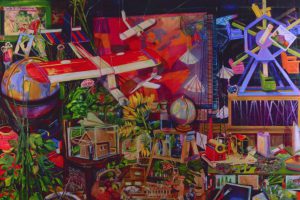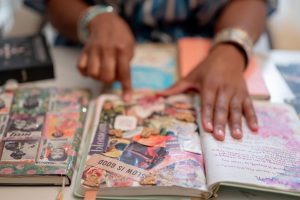![]()
Knowing an artist personally and over a long period of time is rewarding. Having met Jeremy Sorese, a comic artist and illustrator, in college, I have had the pleasure to watch his work change and grow. In Sorese’s art there is a tension between a commitment to readability and a love of detail and abstraction. It is his strong sense of organization that allows Sorese to fill his panels and illustrations with densely packed visual information without losing clarity. Sorese’s recent move to Chicago has only pushed his work further out of the bounds of what is typically explored in comics. I stopped by Sorese’s apartment to chat with him about how living in Chicago has impacted his work.
Miles Johnson: Tell me a little about yourself and your work.

Jeremy Sorese: I’m both a fairly recent graduate of the Savannah College of Art and Design, and a transplant to the Windy City. My artistic focus is in both illustration and comic books, which I think work against one another rather nicely. I definitely pull a lot of my inspiration from the long history of American illustration in my work. I’m a little obsessed with the bygone days of institutions like the Saturday Evening Post, Playboy and the New Yorker, when illustration was a 9 to 5 career in an office building. Its an era that produced an unbridled amount of work that graced nearly every home in American with a level of craftsmanship that can’t be matched in this new computer savvy age. I often feel like the goal of my work is to adapt that tradition to our changing times, to match new tastes without looking stale or played out.
MJ: Could you tell me a little bit about your creative process?
JS: With the Internet in mind, my inspiration usually comes from taking advantage of all of the information available on the World Wide Web, absorbing as much of it as I can stomach at one time, and then sorting through it on the blank page. When I’m not plugged into my router, I try to take Chicago up on all that it offers, with its countless libraries and museums and events going on at a nearly constant basis. The process of crafting comics is a lot different than the illustration work I do. Clarity is something I always try and keep in the forefront of my mind, especially in comics. To make sure everything stays completely legible, I’ve been doing around three or four passes of thumbnails, or the schematics for the future finished comic page. With each pass I get a little tighter as the story take shape. Even on the finished artwork itself, I make more adjustments to pacing and dialogue. I try and keep nothing sacred till it is an inked line and even then it isn’t safe.

MJ: What kinds of stories do y ou like to tell?
JS: I’ve actually been spending a lot of time thinking about what kinds of stories I’d love to tell, now and in the future. In comics, I’ve been really aware of how segmented and disjointed the medium is. People often get upset when the non-comic book literate talk about comics as a “genre”. It isn’t (it’s a medium) but I think that from the outside looking in, it does appear that comic creators tell only a certain number of stories. We have the mainstream superhero bunch, the secular independent D.I.Y. crowd and the very Manga inspired. Very little crossover occurs which I think is really detrimental to an already insular group of artists. As an art student who went to school for comic books, this separation was really extreme with my fellow students and very few would read material outside of their party lines.
With this in mind, I’m trying to push my own work in this direction especially with my next project. It is very close to my own life, yet another tale of love gone awry. I could have very easily taken it verbatim from my own life; maybe orchestrated some changed names or facts and had a complete story already written for me. Instead I’m removing as much of myself from it as possible to forge a better story rather than a sob story. My goal is to use that sincere nugget of my real life experience in combination with the possibility of satire that is found in Science Fiction stories. Neither my ex or I are directly in my story because I’m setting it in the future, allowing the cross discipline of Science Fiction and Indie comics to feed off of one another, to make something better than either could on their own.
MJ: Has moving to Chicago inspired your work in any way?
JS: Chicago is the biggest place I’ve ever lived in. It hasn’t been insurmountable living here, but the city’s sheer size is often a little daunting. The project I just completed, a 45-page story called In the Parlor Room is a direct example of how living in a huge city has influenced me. The comic is filled with nothing but huge ornately decorated buildings, which I doubt would have ever come out of me if I were still living in sleepy little Savannah, Georgia. My work has always been densely filled with visual information, but my time here is just amplifying that aspect of my work.
MJ: What do you think of the opportunities for comic artists in Chicago? What would you change?

JS: I don’t think Chicago specifically has more or less opportunities for comic artists than anywhere else. Sure, we have really wonderful comic shop as well as plenty of zine centric events (C2E2 and the Columbia Zine Fest) but in this new age of the Internet, you can live anywhere as long as you are making work. The Internet does all the footwork for you in terms of finding your readers and distributing content to them.
Finding a working community of artists, on the other hand, is still as important as ever which is one thing Chicago is not missing. All of the artists I’ve met here have been nothing short of immensely generous to me in both feedback and praise and have truly made me feel at home here.
MJ: You teach a monthly class on the art of comics at Challengers Comics. How has that experience been so far?
JS: It has been really wonderful so far.
At this point I haven’t even been out of school for a full year yet, which has made teaching a little tough because I feel like I’m still pretty green about comics. My first class was sort of a disaster because my students didn’t know what they wanted out of the class, and I didn’t know what to teach. Now that I’m approaching my fourth class, I feel like I’m beginning to get a handle on teaching. In many ways, it’s been almost reeducation for me, as I have had to think about comics from a teaching perspective, breaking down what I do into the why I do it for my students. It’s like what I was saying earlier about comics being so insular. Comics are largely drawn by those who are already fluent in comics, which means that many of the visual cues and comic-specific languages we use mainly out of habit, often don’t make sense to those who are newly literate.
And the folks down at Challengers have been nothing short of spectacular to me. The owners, Patrick and Dal are really wonderful guys and I’ve been so lucky to be a part of their team.

MJ: Do you remember the first piece of work you ever created in your career? How does it compare to the most recent?
JS: Comics used to take me forever. I did a five-pager called Dumb Luck between my freshman and sophomore year of college that took me three months. A lot of what slowed me down was the insurmountable fear of the blank page, and trying to make sense of that. While making comics is more of a job now, there was a time when it was new and intimidating. The comic I’m doing now, which is 45 pages, has taken me 3.5 months. So, 5 pages in 3 months to 45 pages in 3 months is a jump. Comics are definitely a marathon. As time goes on I’m definitely building up my endurance for larger and larger projects.
MJ: Where would you like to see yourself and your work in the next 5 years?
JS: I’m definitely looking forward to that full graphic novel I’ll be sitting on in the future.
I’m really interested in how my comics will change in content as I age. Comics have a reputation for being kid stuff, which is only bolstered I think by the fact that most creators are on the younger side, that 18-34 age demographic. I think the most exciting part about postulating about my future comic endeavors is the idea of more adult stories. I’m not talking about grittier or more gratuitous or more violent, but more sophisticated and sincere. I hope I’m still not making stories about 20-somethings when I’m a 40-something. Comics have the beautiful ability to be a way to capture life immediately for others to consume and enjoy and I get so excited thinking about being a father or settling down and making comics that stem from that new stage in my life. The “coming of age story” is the bulk of material coming out of comics these days, which is such a small portion of the human experience.
MJ: What are you doing right now? What shows are you in or preparing for? What series of work are you investigating, starting or thinking about starting?
JS: Right now, I’m in the middle of a four month sabbatical from having a day job to work on what I love full time. I’m finishing up that 45-page story I mentioned earlier which I’ll be printing and selling at both C2E2 and the Columbia Zine Fest here in Chicago. In the beginning of May I’ll be traveling to Toronto for the Toronto Comics Art Festival. Then it’s back to Chicago for Wizard World in August.
And I’ll still be teaching my class at Challengers comics once a month as well. Class dates are always posted on the Challengers website as well as on my personal website. In the upcoming weeks, my site is being overhauled into a place for me to serialize my comics online so stay tuned for that.



